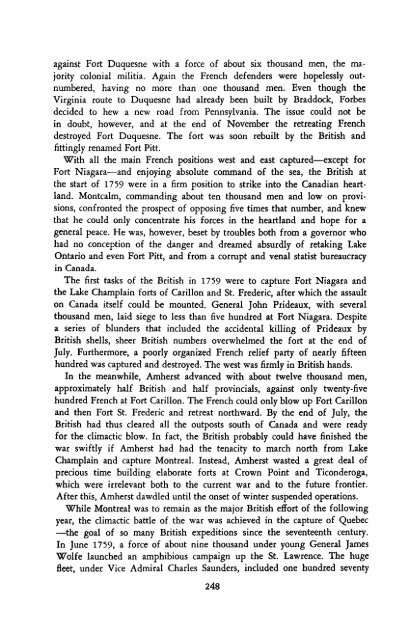Conceived in Liberty Volume 2 - Ludwig von Mises Institute
Conceived in Liberty Volume 2 - Ludwig von Mises Institute
Conceived in Liberty Volume 2 - Ludwig von Mises Institute
You also want an ePaper? Increase the reach of your titles
YUMPU automatically turns print PDFs into web optimized ePapers that Google loves.
aga<strong>in</strong>st Fort Duquesne with a force of about six thousand men, the majority<br />
colonial militia. Aga<strong>in</strong> the French defenders were hopelessly outnumbered,<br />
hav<strong>in</strong>g no more than one thousand men. Even though the<br />
Virg<strong>in</strong>ia route to Duquesne had already been built by Braddock, Forbes<br />
decided to hew a new road from Pennsylvania. The issue could not be<br />
<strong>in</strong> doubt, however, and at the end of November the retreat<strong>in</strong>g French<br />
destroyed Fort Duquesne. The fort was soon rebuilt by the British and<br />
fitt<strong>in</strong>gly renamed Fort Pitt.<br />
With all the ma<strong>in</strong> French positions west and east captured—except for<br />
Fort Niagara—and enjoy<strong>in</strong>g absolute command of the sea, the British at<br />
the start of 1759 were <strong>in</strong> a firm position to strike <strong>in</strong>to the Canadian heartland.<br />
Montcalm, command<strong>in</strong>g about ten thousand men and low on provisions,<br />
confronted the prospect of oppos<strong>in</strong>g five times that number, and knew<br />
that he could only concentrate his forces <strong>in</strong> the heartland and hope for a<br />
general peace. He was, however, beset by troubles both from a governor who<br />
had no conception of the danger and dreamed absurdly of retak<strong>in</strong>g Lake<br />
Ontario and even Fort Pitt, and from a corrupt and venal statist bureaucracy<br />
<strong>in</strong> Canada.<br />
The first tasks of the British <strong>in</strong> 1759 were to capture Fort Niagara and<br />
the Lake Champla<strong>in</strong> forts of Carillon and St. Frederic, after which the assault<br />
on Canada itself could be mounted. General John Prideaux, with several<br />
thousand men, laid siege to less than five hundred at Fort Niagara. Despite<br />
a series of blunders that <strong>in</strong>cluded the accidental kill<strong>in</strong>g of Prideaux by<br />
British shells, sheer British numbers overwhelmed the fort at the end of<br />
July. Furthermore, a poorly organized French relief party of nearly fifteen<br />
hundred was captured and destroyed. The west was firmly <strong>in</strong> British hands.<br />
In the meanwhile, Amherst advanced with about twelve thousand men,<br />
approximately half British and half prov<strong>in</strong>cials, aga<strong>in</strong>st only twenty-five<br />
hundred French at Fort Carillon. The French could only blow up Fort Carillon<br />
and then Fort St. Frederic and retreat northward. By the end of July, the<br />
British had thus cleared all the outposts south of Canada and were ready<br />
for the climactic blow. In fact, the British probably could have f<strong>in</strong>ished the<br />
war swiftly if Amherst had had the tenacity to march north from Lake<br />
Champla<strong>in</strong> and capture Montreal. Instead, Amherst wasted a great deal of<br />
precious time build<strong>in</strong>g elaborate forts at Crown Po<strong>in</strong>t and Ticonderoga,<br />
which were irrelevant both to the current war and to the future frontier.<br />
After this, Amherst dawdled until the onset of w<strong>in</strong>ter suspended operations.<br />
While Montreal was to rema<strong>in</strong> as the major British effort of the follow<strong>in</strong>g<br />
year, the climactic battle of the war was achieved <strong>in</strong> the capture of Quebec<br />
—the goal of so many British expeditions s<strong>in</strong>ce the seventeenth century.<br />
In June 1759, a force of about n<strong>in</strong>e thousand under young General James<br />
Wolfe launched an amphibious campaign up the St. Lawrence. The huge<br />
fleet, under Vice Admiral Charles Saunders, <strong>in</strong>cluded one hundred seventy<br />
248
















